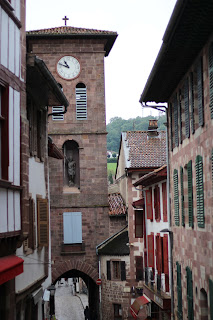On Friday, September 9th, the tour left Bayonne for St.-Jean-Pied-de-Port ("St. John Foot of the Pass"), at the mouth of the famous Pass of Roncesvalles, site of the "Song of Roland." The real Roland was killed not by an enormous horde of Saracens, as in the Song, but when Charlemagne's rearguard was ambushed by Basques, angered by the sack of Pamplona.
This was the first and last rainy day on our tour, and the rain didn't last long.
St.-Jean is the beginning of the "French Route" of the Camino de Santiago, the medieval pilgrim route to the shrine of St. James at Santiago de Compostela. Though "beginning" is a misnomer. The Camino had various ways from and through most places in Europe, including Scandinavia. We were once on a train from Lucerne to Interlaken in Switzerland with a group of developmentally disabled people who had backpacks and the scallop-shell emblem of the Camino. They were gradually working their way through the Swiss part of the Camino (the "Jacobsweg"), and got off to walk over the Brunig Pass.
Francisco pointed out how enormously popular this pilgrimage was. It had advantages over the other two major pilgrimages, to Rome and Jerusalem (the name "Palmer" means that you have an ancestor who made it to the Holy Land and back). It is likely that if you have European ancestry, one or more of your ancestors walked to Santiago.
We went up through the old town to the city gate, where we had our first group photo.
Mary Joy and I went up into the Citadel.
Back in the town, we bought two pairs of cheap hiking sticks, since Francisco had warned us that our upcoming day on the Camino would start out steep and rough. Normally, we wouldn't bring hiking sticks to Europe, since they can't be carried on into the cabin. But since we were checking one piece of luggage anyway, we decided that sticks would be useful in Switzerland as well.
Back on the bus, and through the pass--a lengthy, heavily-wooded drive into Spain. One can see how an eighth-century rearguard could be under deadly attack by locals who knew the ground.
We stopped at Romcesvalles itself and visited the church there, built by Sancho VII ("the Strong"), King of Navarre, as the site of his tomb.
Navarre, or Navarra, is one of the seven provinces (three in France, four in Spain) claimed by Basque nationalists.
Since this is a tour of the Basque Country, I should say something about the Basques.
The Basque language is unlike any other in the world. It was probably the language spoken in the area, before the arrival of Indo-European Celtic and Romance languages. The Roman lack of interest in the western Pyrenees meant that there wasn't pressure to learn Latin. The Franco dictatorship did its best to suppress Basque language and culture, but since Franco's death in 1975, there has been a renewed push, as in Catalonia, for Basque reinvigorization.
Aside from heavy industry in the Bilbao area, the Basque economy has historically been based on fishing, mining and sheep-herding. The biggest group of Basque-Americans is in Boise, Idaho, the descendants of shepherds.
Since it was a nice day, Francisco suggested that we get a preview of our Camino walk, by walking to our lunch stop.
After lunch, the bus took us to Pamplona, the capital of Navarra. Our hotel, Hotel Pompaelo (the city's Roman name, after Pompey) was right on the plaza opposite city hall.
That evening, Francisco taught us how to order
pintxos, the Basque version of tapas, at a bar called Gaucho.






































No comments:
Post a Comment